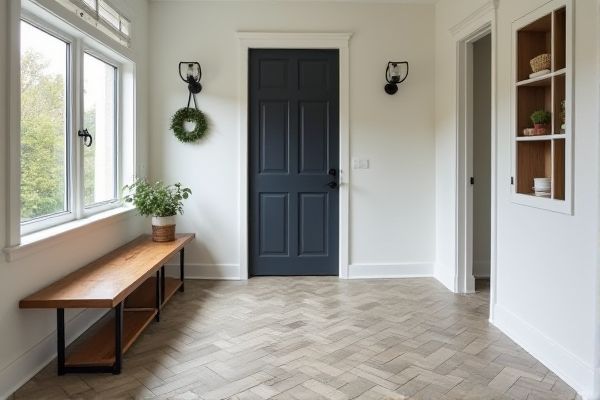
Mudroom herringbone tile creates a dynamic, visually appealing pattern that adds texture and interest to your space while offering durability for high-traffic areas. Straight lay tile provides a clean, classic look with easier installation and maintenance, making it a practical choice depending on your style and function preferences--explore the rest of the article to discover which tile pattern suits your mudroom best.
Table of Comparison
| Feature | Herringbone Tile | Straight Lay Tile |
|---|---|---|
| Design | V-shaped zigzag pattern, dynamic and decorative | Simple grid pattern, classic and clean look |
| Visual Impact | Creates texture and movement, focal point | Offers uniform and subtle appearance |
| Installation Complexity | Requires precise cuts and alignment, higher labor cost | Faster and easier to install, cost-effective |
| Maintenance | More grout lines, moderate cleaning effort | Fewer grout lines, easier cleaning |
| Durability | Same tile material durability, pattern does not affect strength | Same tile material durability, stable layout |
| Best For | Mudrooms needing a stylish, upscale look | Mudrooms prioritizing simplicity and budget |
Introduction to Mudroom Tile Patterns
Mudroom tile patterns such as herringbone and straight lay significantly impact both aesthetics and functionality. Herringbone tile features a zigzag pattern that adds visual interest and can make small mudrooms appear larger, while straight lay tile offers a clean, classic look with straightforward installation. Choosing between these patterns depends on desired style, room size, and maintenance considerations.
What Is Herringbone Tile Layout?
Herringbone tile layout features rectangular tiles arranged in a zigzag pattern creating a distinctive V-shaped design that adds visual interest and dimension to mudrooms. This pattern enhances the aesthetic appeal by introducing texture and movement compared to straight lay tiles, which are installed in a simple grid or linear pattern for a clean, classic look. Herringbone layouts require precise installation but offer a timeless style that complements both traditional and modern interiors, making them a popular choice for mudrooms seeking a stylish yet functional flooring option.
What Is Straight Lay Tile Layout?
Straight lay tile layout features tiles aligned in a grid pattern with edges parallel to the walls, creating a clean and simple look. This design is popular for mudrooms due to its straightforward installation and classic appearance, making maintenance easier. You can choose this layout for a timeless aesthetic that enhances durability in high-traffic areas.
Design Aesthetics: Herringbone vs Straight Lay
Herringbone tile in mudrooms creates a dynamic, visually engaging pattern that adds texture and sophistication, enhancing the overall design aesthetic. Straight lay tile offers a clean, streamlined look with simplicity and uniformity, emphasizing spaciousness and minimalism. The choice between herringbone and straight lay impacts the room's style, with herringbone providing a bold, classic appeal and straight lay supporting modern, understated elegance.
Durability and Functionality in Mudrooms
Herringbone tile in mudrooms offers enhanced durability due to its interlocking pattern distributing weight more evenly, reducing wear over time compared to straight lay tile. The angled design of herringbone also improves slip resistance, important for high-traffic, moisture-prone mudroom areas. Straight lay tile provides straightforward installation and repair, but may not offer the same level of structural resilience or traction as herringbone in demanding mudroom environments.
Installation Complexity and Cost Comparison
Herringbone tile installation in mudrooms requires precise cutting and alignment, increasing labor time and overall costs compared to straightforward straight lay tile patterns. Straight lay tiles offer simpler installation with faster setup, reducing labor expenses and making them more budget-friendly for homeowners. Material costs remain similar, but herringbone's intricate design often leads to higher project prices due to skilled labor demands and potential tile wastage.
Maintenance and Cleaning Considerations
Herringbone tile in your mudroom offers a design that can hide dirt and stains more effectively due to its intricate pattern, requiring less frequent intensive cleaning compared to straight lay tile. Straight lay tiles, with their uniform grout lines, simplify routine maintenance and make grout cleaning more straightforward and quicker. Choosing between the two depends on your preference for maintenance ease versus the ability to disguise wear and tear over time.
Best Tile Types for Herringbone and Straight Lay
Porcelain and ceramic tiles are ideal for both herringbone and straight lay patterns in your mudroom due to their durability and water resistance. Natural stone, such as marble or travertine, complements herringbone layouts with its unique veining, while straight lay patterns benefit from larger format tiles like slate or terracotta for a clean, classic look. Choosing the right tile type ensures longevity and aesthetic appeal tailored to your mudroom's design.
Pros and Cons: Herringbone vs Straight Lay in Mudrooms
Herringbone tile in mudrooms offers a dynamic, visually striking pattern that enhances space with a sophisticated, timeless appeal but can be more challenging and costly to install due to its intricate layout. Straight lay tile provides a clean, classic look with easier installation and maintenance, often resulting in lower labor costs and quicker project completion. Your choice depends on balancing aesthetic preference against budget and installation complexity for an efficient, stylish mudroom design.
Choosing the Right Tile Pattern for Your Mudroom
Choosing the right tile pattern for your mudroom impacts both aesthetics and functionality, with herringbone tile creating dynamic visual interest and a sense of movement. Straight lay tile offers a classic, clean look that is easier to install and maintain, making it ideal for high-traffic areas. Your decision should balance style preferences with practical needs, considering how each pattern complements your space and daily use.
 homyna.com
homyna.com